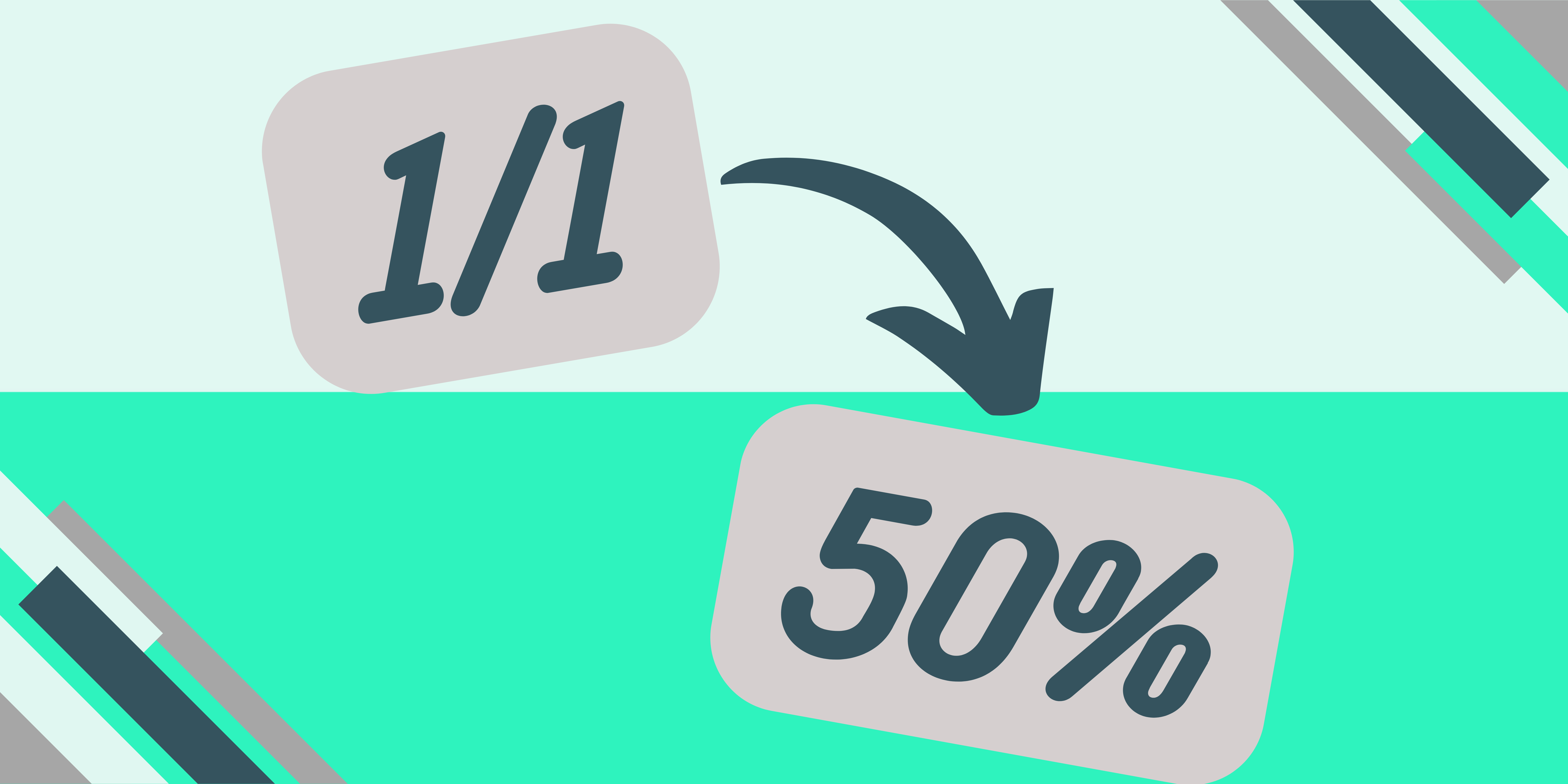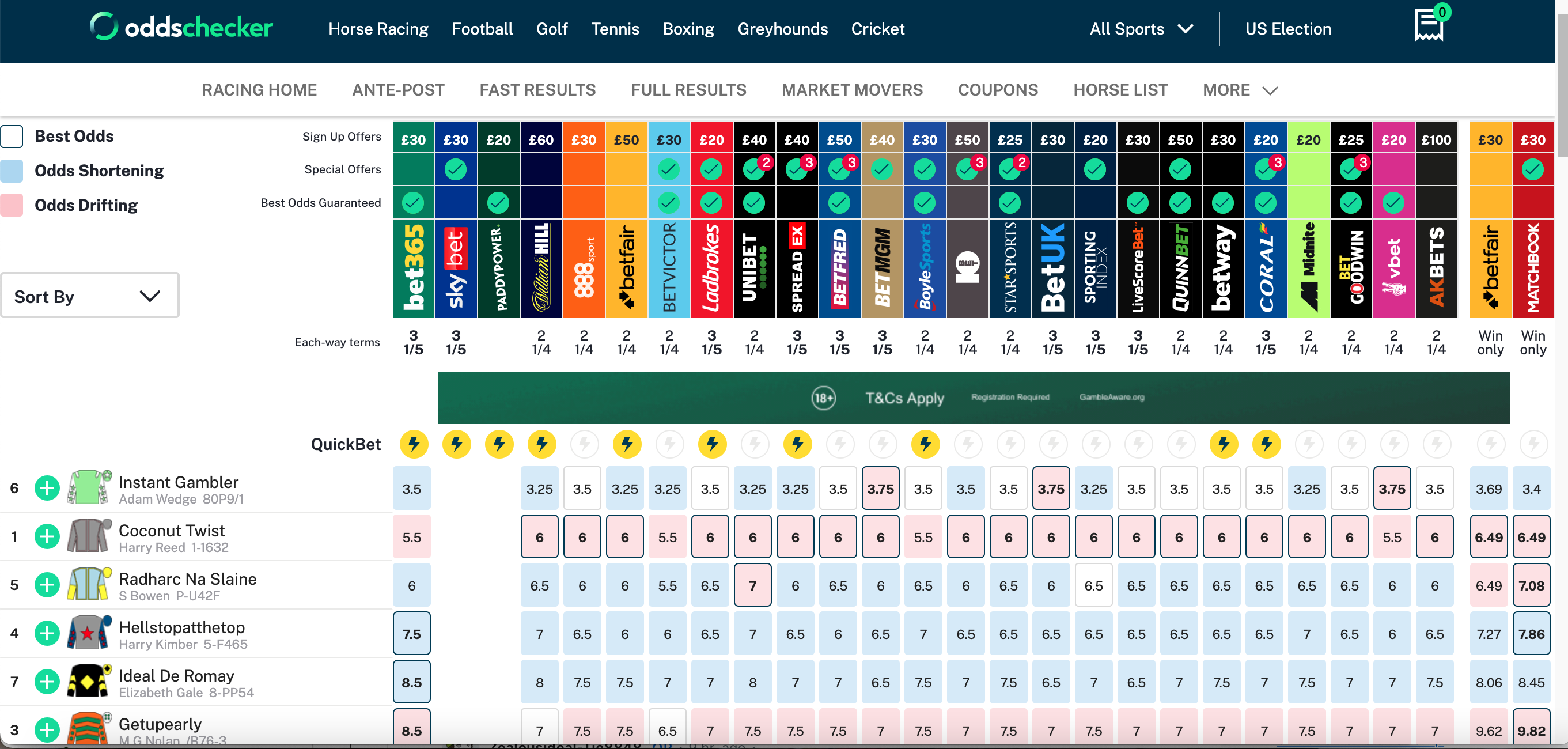How To Read Betting Odds: A Step By Step Guide
We’ve all encountered betting odds in life at least occasionally.
Even for those of us who’ve never visited a betting shop, racecourse, or bookie website, betting odds will crop up on the news or in general discussion.
But if you don’t know how they work, they can be distinctly mystifying, especially when they’re in the form of fractions but don’t seem to correlate to how fractions actually work.
Our step by step guide will take you through everything you need to know to read and understand betting odds in every major format so that you’re never baffled again when you come across betting odds on a betting site, or out in the wild.
What Are Betting Odds?
Betting odds represent the amount somebody can expect to win in the event of their bet being successful. The higher the odds, the more a bettor will get if they win their bet, while lower odds will result in a much more modest return.
Because of the way betting works, betting odds also become a representation of probability.
Higher odds mean that an outcome is considered much less likely to occur, while low odds will indicate that a team or player is the favourite to win.
Indeed, betting odds have become so ubiquitous in life that the word ‘odds’ has become a colloquial synonym for ‘chances’ - e.g. ‘Wow, what are the odds of that happening?’
People often interpret betting odds as a direct translation of the likelihood of something happening - but while they certainly offer an indication of that likelihood, it’s important to remember that’s not all they’re doing.
Bookies manipulate their odds to guarantee themselves profits (more on that later), often resulting in a skewed set of odds for many events.
When considering betting odds, keep in mind that they don’t directly represent the true chances of something happening.
Types Of Betting Odds And How To Read Them
Betting odds come in a few formats, which each dominate in different parts of the world.
Although there’s no ‘correct’ betting odds format, some are certainly more confusing than others to the layperson.
In each case, though, once you’re used to reading odds in a certain format, it’ll probably feel like the ‘right’ format for you.
There are three main types of odds used in the western world.
Fractional (British)
The traditional format for betting odds in the UK is fractional. At first glance, fractional betting odds can look very confusing, but they’re reasonably straightforward once you know your way around them.
Fractional odds indicate the amount you will win depending on your original stake, with the first number showing your winnings, and the second your stake. Here are a few examples below:
2/1 odds indicates that for every £1 staked you will win £2 (equal to 3.0 in decimal odds and +200 in moneyline odds)
1/2 odds indicates that for every £2 staked you will win £1 (equal to 1.5 in decimal odds and -200 in moneyline odds)
5/4 odds indicates that for every £4 staked you will win £5 (equal to 2.25 in decimal odds and +125 in moneyline odds)
The only trouble with fractional odds is that it can be quite difficult to compare them, especially if you’re not yet very comfortable with reading them. This means that you might not always be certain of whether one set of odds is better than another.
Decimal (European)
For many people, decimal odds are the easiest to understand. They’re used mostly in Europe, but are catching on in the UK as well. With decimal odds, you simply multiply your stake by the odds to calculate your total return (including your original stake) on a bet. For example:
3.0 odds means that if you bet £1, you receive a total of £3 if your bet wins (equal to 2/1 in fractional odds and +200 in moneyline odds)
1.5 odds means that if you bet £1, you receive a total of £1.50 if your bet wins (equal to 1/2 in fractional odds and -200 in moneyline odds)
2.25 odds means that if you bet £1, you receive a total of £2.25 if your bet wins (equal to 5/4 in fractional odds and +125 in moneyline odds)
The maths involved for decimal odds is therefore much easier, but it’s important to remember that you’re calculating your total return, not just your winnings, as is the case for fractional odds.
Moneyline (American)
To non-Americans, moneyline odds are the most confusing of all. To start with, they come in two different formats, depending on the likelihood of an outcome. For an outcome that is more likely than not to occur (i.e. a favourite), moneyline odds are expressed in the negative, while for an outcome that is less likely to occur (i.e. an underdog), the odds are expressed in the positive.
For a favourite, the odds indicate the amount you have to bet in order to win £100 (or, as they’re more commonly used in the US, $100). For an underdog, meanwhile, the odds indicate the amount of profit you’ll make if you bet £100.
+200 odds means that if you bet £100, you’ll make £200 in profit if your bet wins (equal to 2/1 in fractional odds and 3.0 in decimal odds)
-200 odds means that you need to bet £200 in order to make £100 in profit if your bet wins (equal to 1/2 in fractional odds and 1.5 in decimal odds)
+125 means that if you bet £100, you’ll make £125 in profit if your bet wins (equal to 5/4 in fractional odds and 2.25 in decimal odds)
This format is rarely used in the UK, and British bettors are therefore unlikely to want to use it - but it never hurts to have a basic understanding of how these things work.
Converting between types of odds
You’re fairly unlikely to need to do much converting most of the time, as most betting sites allow you to choose your preferred format of odds in your account settings. Pretty much all bookie sites will allow you to choose between fractional and decimal odds, while some will also include moneyline odds, and the odd one will even include some more exotic odds formats, such as Indonesian or Malaysian odds.

Occasionally, though, you may need to convert from one format to another - for example if you’re completing an offer where the minimum odds are expressed in fractional format, and you prefer decimal.
While you certainly can put your brain to use and work out the maths by hand, the easiest way to do so is to use an odds converter.
Converting Betting Odds To Probability

It can be useful to work out the implied probability from the odds you’re seeing for a particular selection - i.e. the approximate likelihood of that selection winning.
For each type of odds, there’s a different calculation you can use to work out the probability (though you can again simply use an odds converter).
Fractional odds
To turn fractional odds into probability (as a percentage), you can use the following formula, with the odds expressed as x/y:
(y / (x + y)) * 100
So for example, you would do the following calculation for odds of 2/1:
(1 / (2 + 1)) * 100
(1 / 3) * 100
0.33 * 100 = 33
= 33% probability
Decimal odds
Decimal odds are perhaps the easiest to convert to probability - the formula is simply 100/odds.
For example, for decimal odds of 4.0, you would do the following calculation:
100/4 = 25
= 25% probability
Moneyline odds
Moneyline odds are probably the most awkward to convert to probability, as you have two different calculations to perform depending on whether the odds are positive or negative.
Underdogs
For underdogs (with positive odds), we use a similar method to fractional odds. First, divide the odds by 100, and then use the formula (1 / (x + 1)) * 100 to work out the probability.
For example, for moneyline odds of +400, you would do the following calculation:
400 / 100 = 4
(1 / (4 + 1)) * 100
(1 / 5) * 100
0.2 * 100 = 20
= 20% probability
Favourites
For a favourite, we use the same formula, but then subtract the end result from 100.
For example, for moneyline odds of -400, you would do the following calculation:
400 / 100 = 4
100 - ((1 / (4 + 1)) * 100)
100 - ((1 / 5) * 100)
100 - (0.2 * 100)
100 - 20 = 80
= 80% probability
How Are Betting Odds Determined?
People often assume that betting odds are a direct representation of the likelihood of something happening, but that isn’t necessarily the case.
For a full explanation of the various techniques bookies use to determine odds, check out our guide - but we’ll talk you through the basics here.
There are a few different factors that go into the algorithms that bookies’ software uses to decide odds, which can roughly be broken down into two categories.
Likelihood
It’s not the only consideration that goes into betting odds, but it’s certainly an important one!
Bookies will use enormous amounts of data, including past performance of each team/player/competitor, weather and other conditions, and past matchup results, to assess the likelihood of all possible outcomes within a match or race.
Profit
A bookie doesn’t exist to predict the future - its reason for existence is to make money, and it ensures itself profit through its oddsmaking.
An ‘overround’ is factored into the odds you see on a bookie’s website, which is their margin on their pricing.
They also adjust their odds constantly as people make bets, aiming for the same volume of betting on all sides of an event.
This allows them to ensure that they make their profit regardless of the outcome of that event.
How To Find The Best Betting Odds
The available odds for a certain event can vary quite drastically from bookie to bookie.
This can mean a pretty major difference to your potential profit, so if you’re looking to place a bet on a particular match or race, it’s worth your while finding the bookie with the best odds.
Fortunately, there are tools online to help you do exactly this, so there’s no need to trawl through the bookies’ sites manually looking for the highest odds.
Websites such as Oddschecker compare the odds from the biggest UK bookies to allow you to find the highest odds for whatever you want to bet on.
You can see the results for a horse race at Fontwell below as an example:

Of course, you probably won’t want to have accounts with all the major UK bookies (unless you’re getting into Matched Betting, that is), but you’ll be able to quickly identify which bookies are your best options out of those you do have accounts for. You can also easily change between decimal and fractional odds, depending on your preference.
Common Betting Odds Terms

There are an enormous number of sports betting terms, some more obscure than others, but we’ve listed some of the most common odds-related terms below.
Arbitrage - arbitrage betting, or ‘arbing’, means placing a matched bet where the bookie’s odds are higher than the exchange’s, resulting in an instant profit
BOG (Best Odds Guaranteed) - many bookies will have a small ‘BOG’ symbol at the top of a number of races. This indicates they will pay out at the best odds offered by any bookie at the start of the race, even if your bet is placed at lower odds
Drift - odds that are ‘drifting’ are lengthening, or growing larger
Evens - odds of 1/1 in fractional format or 2.0 in decimal format, where the amount you win is even with your stake
Favourite - the team or runner considered most likely to win an event
Fixed-odds betting - a bet where the odds cannot change once you have placed your bet, meaning you can be sure of the amount you stand to win
Long shot - a selection with a minimal chance of winning an event, usually at high odds, meaning a significant return if it does win
Nailed on - a selection considered to be almost certain to win
Odds against - a term indicating that the odds are higher than evens
Oddsmatcher - Outplayed’s Oddsmatcher automatically compares the odds between bookies and betting exchanges, and displays the best bets for matched bettors to select
Odds on - effectively the opposite of ‘odds against’, odds on means that the odds are lower than evens
Shorten the odds - this means that the odds on a team or competitor have been reduced by the bookies, as they consider the competitor to have become more likely to win
Starting Price (SP) - the starting price is the prevailing odds for a horse at the start of a race. You might choose to bet on the starting price in advance of a race, rather than the odds offered at the time of your bet, if you’re confident that the odds will have improved by the time the race goes off.
Underdog - the opposite of the favourite, an underdog is not expected to win their event
How To Interpret Odds When Matched Betting
Particularly when you first start Matched Betting, it’s extremely important to be able to compare odds quickly and easily. For this reason, we recommend sticking to odds in decimal format, which allows you to compare odds at a glance, with no need for hasty mental maths, or to memorise fractional equivalents.
Our Oddsmatching software will do a lot of the work for you, of course, providing a list of close matches between bookies and exchanges for any bookie you choose. There are a couple of good rules of thumb to bear in mind when choosing a match to bet on, though:
1. For a qualifying bet, you should look for relatively low odds where possible. This helps to keep your qualifying loss to a minimum. You do need to make sure that your qualifying bet is higher than the minimum odds set in the bookie’s terms for the offer, however.
2. For a free bet, higher odds tend to produce higher profits. Where possible, it’s best to look for odds of at least 5, or even higher still, to maximise your profits. This will also increase your liability at the exchange, though, so double check to make sure you’ve got sufficient bankroll to cover your lay bet.
Summary
To newcomers, betting odds and their varying formats can seem off-putting at first, but once you know your way around them they’re easy enough to understand.
Although fractional odds are traditional in Britain, most people find decimal odds clearest to understand - and if you’re a matched bettor, it’s even more important to be able to compare odds with ease.
Nonetheless, it’s entirely up to you which odds format you prefer, and most bookies will allow you to set your preferences accordingly.
Finally, if you ever need to convert between odds formats and/or probabilities, there are plenty of tools to help - including our very own odds converter and probability calculator.
Updated: 27 Dec 2024
The Author
Stephanie is a published author and, having taken up Matched Betting fairly recently, she knows exactly how beginners feel when they first start Matched Betting. She loves breaking down complex subjects in straightforward terms to make them accessible to newcomers, and to speed them on their way to making their first profits.

